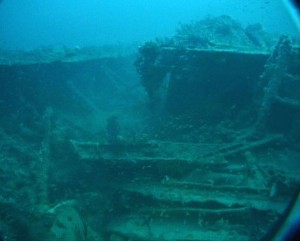
NORFOLK, Va. — World War II shipwrecks off North Carolina and Civil War shipwrecks in Virginia are being analyzed with sonar technology so sophisticated that the public could one day view near photographic images in detail even better than diving at some of the sites could provide.
Federal researchers are using sonars to gather data that will result in vivid, three-dimensional images of the shipwrecks that will likely end up online, in museums and as part of other programs designed to promote American maritime heritage.
“Not everybody dives, and so that’s why we embrace technologies like this that are cutting edge, cost effective and give you a three-dimensional sense of that ship on the bottom,” said James Delgado, director of the National Oceanic and Atmospheric Administration’s Maritime Heritage Program. “The kinds of imagery — it’s almost photographic.”
Shipwrecks are often popular dive sites, but obtaining detailed images of the ships would allow the public to view them without risk of damaging them and also help scientists determine the condition the ships are in as they try to develop better ways to preserve them. The technology also allows the public to view shipwrecks in waters that aren’t very clear.
On Tuesday, researchers headed to North Carolina’s Outer Banks to begin creating images of ships sunk in 1942 during the Battle of Atlantic.
On July 14, 1942, a merchant convoy of 19 ships and five military escorts left the Hampton Roads area of Virginia en route to Key West, Fla., to deliver cargo to aid the war effort. A German submarine attacked Convoy KS-520 the next day off Cape Hatteras, and the U-boat was sunk by depth charges dropped by U.S. Navy aircraft.
“These are sites that are miles out into the sea and so unless you’re a diver you’re likely not to going to be aware of them even. Many people may not know that there were U-boats off the coast of North Carolina during World War II that created a number of casualties,” said Alexis Catsambis, an underwater archaeologist for the U.S. Navy.
Researchers have already identified potential shipwrecks from that battle and the 3-D mapping will help them determine exactly what they’re looking at.
“There’s 400 years of ships sunken off the coast here, so it could be anything. You never know what you’re going to get,” said Joseph Hoyt, maritime archaeologist for the Monitor National Marine Sanctuary.
Eventually, researchers hope to develop 3-D video of individual Battle of the Atlantic shipwrecks.
NOAA researchers used the sonar to map the Civil War shipwrecks USS Cumberland and CSS Florida in the murky waters of the James River near Newport News on Monday. The ships are being researched to identify the best way to protect them as the nation commemorates the 150th anniversary of the start of the Civil War.
The USS Cumberland was sunk on March 8, 1862, during the Battle of Hampton Roads. The ship was part of the U.S. Navy’s North Atlantic Blockading Squadron and was sunk after being rammed by the Confederate ironclad CSS Virginia, which was formerly the USS Merrimack. More than 120 men died.
“In terms of the guys who died in the Cumberland that day, not only are they heroes, but they’re sons and fathers and grandsons and nephews and they left families who are still with us today and their stories resonate,” Delgado said.
The CSS Florida was a Confederate commerce raider that had been captured by the U.S. Navy in Brazil. It was towed back to the U.S. and sank on Nov. 19, 1864, following a collision with a U.S. Navy troop ferry. The ships are protected by federal law, but resources are limited. Researchers hope that by being able to better tell the ships’ stories with new visualizations that they won’t be looted or damaged by divers or unknowing fishermen.
“If people don’t have a personal connection to it, they don’t care about it,” said David Alberg, sanctuary superintendent of the Monitor National Marine Sanctuary. “By doing these types of projects, getting that information out there, that’s helping to educate the public, which is ultimately the most important tool to protecting the site.”
____
Online: Battle of the Atlantic Expedition http://sanctuaries.noaa.gov/missions/2011battleoftheatlantic/


